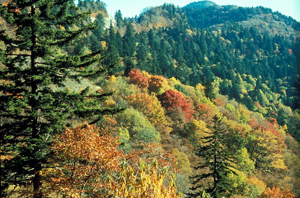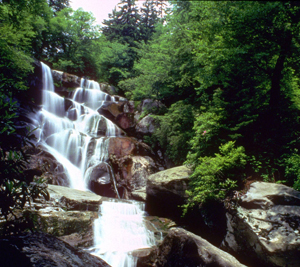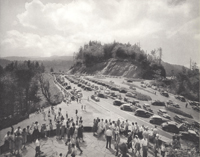Ridge upon ridge of forest straddles the border between North Carolina and Tennessee in Great Smoky Mountains National Park. World renowned for its diversity of plant and animal life, the beauty of its ancient mountains, and the quality of its remnants of Southern Appalachian mountain culture, this is America's most visited national park.

Newfound Gap. NPS Photo
Becoming a national park was not easy for the Great Smokies. Joining the National Park System took a lot of money and the hard work of thousands of people.
Establishing most of the older parks located in the western United States, such as Yellowstone, was fairly easy. Congress merely carved them out of lands already owned by the government-often places where no one wanted to live anyway. But getting park land in this area was a different story. The land that became Great Smokies National Park was owned by hundreds of small farmers and a handful of large timber and paper companies. The farmers did not want to leave their family homesteads, nor did the large corporations want to abandon huge forests of timber, many miles of railroad track, extensive systems of logging equipment, and whole villages of employee housing.
The idea to create a national park in these mountains started in the late 1890s. A few farsighted people began to talk about a public land preserve in the cool, healthful air of the southern Appalachians. A bill even entered the North Carolina Legislature to this effect, but failed. By the early 20th century, many more people in the North and South were pressuring Washington for some kind of public preserve, but they were in disagreement on whether it should be a national park or a national forest.
There are important differences between national parks and national forests, and each concept had its cheering section. In a national forest, consumptive use of renewable resources is permitted under the multiple use management concept. Because the forests were initially set aside for timber harvesting and grazing, the national forests were made a bureau in the Department of Agriculture.
In a national park, however, the scenery and resources are protected, and nature is allowed to run its course. The ultimate decision to establish a national park meant that the scenery, resources, and some of the native architecture would be protected for all people to enjoy into the infinite future.

NPS Photo
The drive to create a national park became successful in the mid-1920s, with most of the hard working supporters based in Knoxville, Tennessee, and Asheville, North Carolina. The two groups had long been competitors over the location of the national park, but they finally began pulling together for a park in the heart of the Smokies, halfway between the two cities.
As a matter of past history and present interest, the park movement was directed not by the hardcore conservationists, backpackers, and trout fishermen, but motorists. The newly formed auto clubs, mostly branches of the AAA, were interested in good roads through beautiful scenery on which they could drive their shiny new cars.

Ramsey cascades (NPS photo)
In May, 1926, a bill was signed by President Calvin Coolidge that provided for the establishment of Great Smoky Mountains National Park and Shenandoah National Park. This allowed the Department of the Interior to assume responsibility for administration and protection of a park in the Smokies as soon as 150,000 acres of land had been purchased.
Since the government was not allowed to buy land for national park use, the former political boosters had to become fund raisers. In the late 1920s, the Legislatures of Tennessee and North Carolina appropriated $2 million each for land purchases. Additional money was raised by individuals, private groups, and even school children who pledged their pennies. By 1928, a total of $5 million had been raised. Trouble was, the cost of the land had now doubled, so the campaign ground to a halt. The day was saved when the Laura Spellman Rockefeller Memorial Fund donated $5 million, assuring the purchase of the remaining land.
"Long deeply interested in creating more parks convenient to the teeming population centers of the eastern part of the country, John D. Rockefeller, Jr. suggested that the Laura Spelman Rockefeller Memorial make a gift of $5,000,000 as a memorial to "the beautiful spirit of my mother." With this gift, matching funds already raised, the Park became a reality. Twenty-five years later, the Directors of the Great Smoky Mountains Conservation Association resolved that the 'timely and far-sighted gift … will stand through the ages as a living memorial to a wonderful woman.' " (1)

Rockefeller Memorial. Photo Credit: Jim Thompson (1, pg 81)
The park was formally dedicated by President Franklin Roosevelt in September, 1940. He spoke from the Rockefeller Monument at Newfound Gap astride the Tennessee - North Carolina state line. That ceremony dedicated a sanctuary that is not a local park, a county park, or even a state park, but a national park for all the people of the country and the rest of the world to enjoy.
-DL
Sources:
(1) Newhall, Nancy. "A Contribution to the Heritage of Every American." New York: Alfred Knopf Publishing. 1957.
Great Smoky Mountains National Park. Park Website: History & Culture: Stories.
https://www.nps.gov/grsm/historyculture/stories.htm
